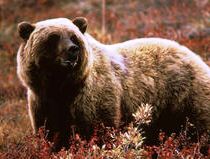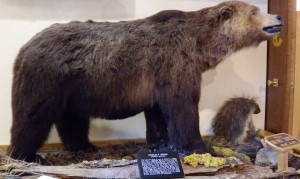» posted on Thursday, August 9th, 2012 by Linda Lou Burton
Horribilis
 Linda Burton posting from Helena, Montana – “We’re headed for Glacier but we don’t expect to do much hiking there,” said the mom of the group. I was chatting with a family of four in the breakfast room; a mom and dad and two grown-up daughters enthusiastic about their holiday. One of the daughters spoke up then. “It’s the grizzlies; we’ve heard they are everywhere.” The other daughter chimed in too. “We saw three on the drive from Colorado. One was eating a deer carcass by the side of the road. He was huge.” I wished them a safe trip and headed upstairs to my computer. Are there in fact a lot of grizzly bears in this part of the country? According to Montana Fish and Wildlife, the grizzly bear, Ursus arctos horribilis, occupies over 6 million acres in the Northern Continental Divide Ecosystem (NCDE) of western Montana, notably Glacier National Park and the Bob Marshall Wilderness; the NCDE is believed to have the largest population of grizzlies in the lower 48 states.
Linda Burton posting from Helena, Montana – “We’re headed for Glacier but we don’t expect to do much hiking there,” said the mom of the group. I was chatting with a family of four in the breakfast room; a mom and dad and two grown-up daughters enthusiastic about their holiday. One of the daughters spoke up then. “It’s the grizzlies; we’ve heard they are everywhere.” The other daughter chimed in too. “We saw three on the drive from Colorado. One was eating a deer carcass by the side of the road. He was huge.” I wished them a safe trip and headed upstairs to my computer. Are there in fact a lot of grizzly bears in this part of the country? According to Montana Fish and Wildlife, the grizzly bear, Ursus arctos horribilis, occupies over 6 million acres in the Northern Continental Divide Ecosystem (NCDE) of western Montana, notably Glacier National Park and the Bob Marshall Wilderness; the NCDE is believed to have the largest population of grizzlies in the lower 48 states.
While it’s true that most grizzlies in the lower 48 today live in western Montana, at one time grizzlies roamed most of North America west of the Mississippi River. Now only a few populations remain, in the Cascade Mountains, and the Northern Rockies. In 1975 grizzlies were listed as “threatened” under the Endangered Species Act. You know what has happened – people moved into bear habitat. And grizzlies have a low reproductive rate. Babies weigh about a pound when they are born in the winter den; they are nursed for the first two years of their lives and obtain adult size in 4 to 6 years. Females first breed at about age 5 and generally breed every 2 to 4 years; they may live as long as 20 years.
about a pound when they are born in the winter den; they are nursed for the first two years of their lives and obtain adult size in 4 to 6 years. Females first breed at about age 5 and generally breed every 2 to 4 years; they may live as long as 20 years.
How big are grizzlies, and what distinguishes them from other bears? Look for a concave face and a hump above the shoulders. They have a massive head and rounded inconspicuous ears. Their eyes are small, their tail is short, and their body is powerful. The most prevalent color of Montana grizzly bears is medium to dark brown. Adult males weigh 400-700 pounds, females 300-400.
What do grizzlies eat? More than half their diet is vegetative; they have long claws for digging; they also eat fish, large and small mammals, insects, carrion and garbage. More bear fatalities have been recorded during poor crop years when they forage at lower elevations and come into contact with humans more often. Montana Fish and Wildlife advises against bird feeders in summer months, they are bear attractants; garbage should be stored in bearproof containers or inside. Bears are attracted to barbecue grills, pet food, fruit trees and gardens; don’t leave food outside and pick your fruits and vegetables as soon as they ripen, if you live in bear country.
So what advice for that family of four headed to Glacier, or any hiker or camper? Get some bear pepper spray; carry it and know how to use it. Inquire about recent bear activity in the area and let someone know where you are going and when you plan to return. Travel in groups and be out in daylight hours. Stay on trails and watch for signs of bears such as bear scat and torn-up logs. Keep children close and make noise –sing a good hiking song as you walk along or carry a bell. The object is to avoid an encounter. Most bears want to avoid humans!
 Worst case scenario if you do encounter a bear (grizzly or any other kind); stay calm, speak softly, and do not make eye contact. Remember, you have your pepper spray and you know how to use it. Do not run, back away slowly. A bear can easily outrun you. (Remember the joke about the camper putting on the running shoes? “I don’t need to outrun the bear,” he told his tent mate, “I just need to outrun you.”) Seriously, don’t try to run or climb a tree. Bears do it better.
Worst case scenario if you do encounter a bear (grizzly or any other kind); stay calm, speak softly, and do not make eye contact. Remember, you have your pepper spray and you know how to use it. Do not run, back away slowly. A bear can easily outrun you. (Remember the joke about the camper putting on the running shoes? “I don’t need to outrun the bear,” he told his tent mate, “I just need to outrun you.”) Seriously, don’t try to run or climb a tree. Bears do it better.
If a grizzly bear charges, remain standing and direct your pepper spray at the charging bear. The bear may run past you. If a grizzly bear attacks during the day, most experts recommend either curling up in a ball or lying face down (flat). Use your hands and arms to protect the back of your neck and face; keep your backpack on for added protection; don’t move or make noise until you are sure the bear has left the area. If a bear attacks at night while you’re in a tent, fight back aggressively with whatever you have available to use as a defensive weapon. The bear may be seeking food rather than trying to neutralize a threat, so fight back to show the bear you are dangerous.
Grizzlies may be intimidating (with a name like Ursus arctos horribilis what else could you be?), but remember, if you’re a hiker or camper, you’re in their territory, so be respectful of their space and reasonable in your behaviors, such as storage of food. Just like us, bears get hungry. They aren’t sitting up nights plotting our demise, they just want to eat. I read that more people are killed each year by snakes, spiders, dogs, bees, tornadoes, lightning, and humans than by any bear!
I’d like to chat again with that family headed to Glacier, but they’re already gone. Meanwhile, my cats are snuggled on the bed against the teddy bear (Ursus sweetus).
In Montana, grizzlies are managed by the Montana Department of Fish, Wildlife and Parks, the U S Fish and Wildlife Service and tribal wildlife managers. Much of their habitat is managed by U S Forest Service and other public and tribal land management agencies. The Interagency Grizzly Bear Committee coordinates management and research activities. http://fwp.mt.gov/fishAndWildlife/livingWithWildlife/grizzlyBears/grizzlyMontana.html
Note: “grizzly” refers to the grizzled gray hairs in the fur of the bear; naturalist George Ord received specimens of the grizzly brought back by Lewis and Clark for description; when he formally named the bear Ursus arctos horribilis in 1815 did he mistake the word “grizzly” for “grisly”? (Ursus is Latin for bear, arctos is Greek for bear, horribilis is Latin for the word grisly.)

